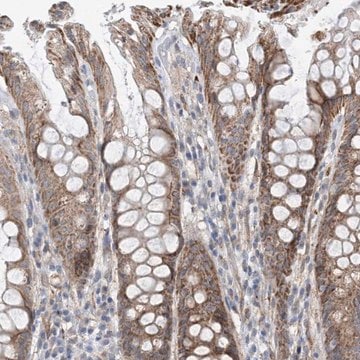03353621001
Roche
5′/3′ RACE Kit, 2nd Generation
sufficient for 10 reactions
Sign Into View Organizational & Contract Pricing
All Photos(1)
About This Item
UNSPSC Code:
41106313
NACRES:
NA.55
Recommended Products
usage
sufficient for 10 reactions
Quality Level
manufacturer/tradename
Roche
shipped in
dry ice
storage temp.
−20°C (−15°C to −25°C)
General description
Rapid Amplification of cDNA ends (RACE) is a prevalent technique used to rapidly obtain full-length cDNA from partially known sequences. The 5′/3′ RACE kit contains Transcriptor Reverse Transcriptase and recombinant Terminal Transferase. Transcriptor Reverse Transcriptase transcribes full-length cDNA for the highly sensitive and rapid amplification of either 5′ or 3′ cDNA fragments up to 14 kb. Due to its thermostability (up to +65 °C), it can work with GC-rich templates with high secondary structure. High sensitivity can be achieved using Transcriptor Reverse Transcriptase, resulting in highly efficient cDNA synthesis and the generation of long RACE products. Recombinant Terminal transferase is used to add a homopolymeric A-tail to the 3′ end of the cDNA. The poly(A)+ tail decreases the likelihood of inappropriate truncation by the oligo(dT)-anchor primer, and overcomes the weaker A/T compared to the G/C hybridization. Moreover, longer stretches of A residues are required before the oligo(dT)-anchor primer can hybridize to an internal site and can truncate the amplification product. Tailed cDNA is amplified by PCR using a gene-specific primer and the oligo(dT)-anchor primer. The obtained cDNA is further amplified by a second PCR using a nested specific primer and the PCR-anchor primer, allowing RACE products to be cloned into an appropriate vector for subsequent studies.
Specificity
Heat inactivation: Terminal Transferase: 70 °C for 10 minutes
Transcriptor Reverse Transcriptase: 85 °C for 5 minutes
Transcriptor Reverse Transcriptase: 85 °C for 5 minutes
Application
5′/3′ RACE Kit, 2nd Generation is suitable for
- Structural and expression studies of RNA molecules
- Generating full-length cDNAs
- Isolation and characterization of 5′ or 3′ ends from low-copy RNA messages
- first strand cDNA synthesis
- Amplification and further cloning of rare mRNAs
- Use in conjunction with exon-trapping methods
- Products of the RACE reaction can be directly sequenced without cloning
Features and Benefits
- Robust performance: Recombinant Transcriptor Reverse Transcriptase allows procession through regions of difficult secondary RNA structure.
- Convenient: Function and expression studies of either 5′ or 3′ end of the RNA can be performed with the same kit.
- Reliable: dA tailing of cDNA with Recombinant Terminal Transferase decreases the likelihood of inappropriate truncation.
- Reproducible: Oligo dT-anchor primer with non 3′dT ensures correct binding to the inner end of the poly (A) tail.
- Produce long fragments: Generate cDNA up to 14kb in length with Transcriptor Reverse Transcriptase.
The control reaction includes transcription of the control RNA into first-strand cDNA using the control primer neo1/rev. Amplification of the cDNA is performed using the control primer neo2/rev and neo3/for to obtain a 157-bp PCR product. Tailing of the purified cDNA is performed with dATP. Amplification of the tailed cDNA is performed with oligo dT-anchor primer and the control primer neo2/rev to obtain a 293-bp PCR product.
Packaging
1 kit containing 12 components
Other Notes
For life science research only. Not for use in diagnostic procedures.
Kit Components Only
Product No.
Description
- cDNA Synthesis Buffer 5x concentrated
- Transcriptor Reverse Transcriptase 20 U/μl
- Deoxynucleotide Mix
- dATP, pH 7.5 (20 °C)
- Reaction Buffer 10x concentrated
- Terminal Transferase, recombinant
- Control neo-RNA 1 ng/μl
- Oligo dT-Anchor Primer
- PCR Anchor Primer
- Control Primer neo1/rev primer 12.5 μM
- Control Primer neo2/rev primer 12.5 μM
- Control Primer neo3/for primer 12.5 μM
See All (12)
Storage Class Code
12 - Non Combustible Liquids
WGK
WGK 1
Flash Point(F)
does not flash
Flash Point(C)
does not flash
Certificates of Analysis (COA)
Search for Certificates of Analysis (COA) by entering the products Lot/Batch Number. Lot and Batch Numbers can be found on a product’s label following the words ‘Lot’ or ‘Batch’.
Already Own This Product?
Find documentation for the products that you have recently purchased in the Document Library.
Customers Also Viewed
Dilek Cansu Gurer et al.
Frontiers in cell and developmental biology, 9, 688855-688855 (2021-09-10)
Cisplatin is a well-known cancer chemotherapeutic agent but how extensively long non-coding RNA (lncRNA) expression is modulated by cisplatin is unknown. It is imperative to employ a comprehensive approach to obtain a better account of cisplatin-mediated changes in the expression
Rapid amplification of 5 [prime] complementary DNA ends (5 [prime] RACE)
Sambrook J and Russell DW
Nature methods, 2, 629-630 (2005)
Erdong Cheng et al.
Journal of virology, 86(18), 10173-10185 (2012-07-13)
Hantaviruses, similarly to other negative-strand segmented RNA viruses, initiate the synthesis of translation-competent capped mRNAs by a unique cap-snatching mechanism. Hantavirus nucleocapsid protein (N) binds to host mRNA caps and requires four nucleotides adjacent to the 5' cap for high-affinity
Rapid amplification of cDNA ends (RACE)
Yeku O and Frohman MA
Methods in Molecular Biology, 107-122 (2011)
Po-Shuan Huang et al.
Cells, 9(4) (2020-04-17)
Hepatocellular carcinoma (HCC) is one of the most common and aggressive human malignancies worldwide. Long non-coding (lnc) RNAs regulate complex cellular functions, such as cell growth, differentiation, metabolism, and metastasis. Although deregulation of lncRNA expression has been detected in HCC
Our team of scientists has experience in all areas of research including Life Science, Material Science, Chemical Synthesis, Chromatography, Analytical and many others.
Contact Technical Service










